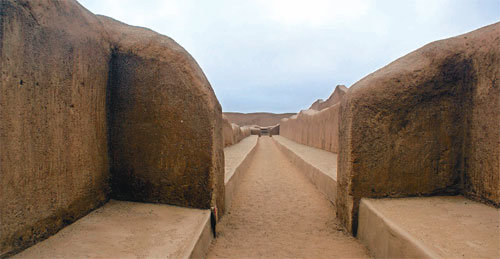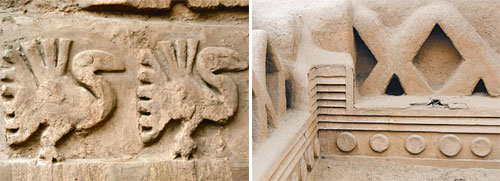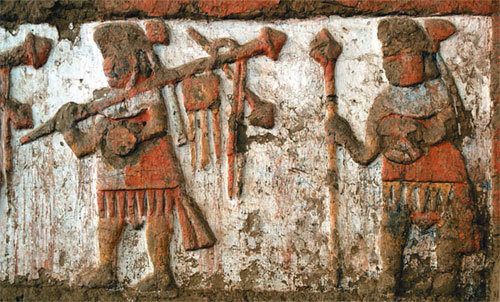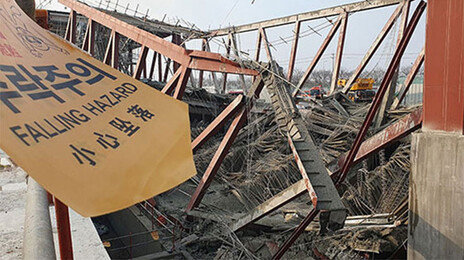공유하기
<1> Peru's Chan Chan Archaeological Zone Hurt by Climate Change
- 동아닷컴
-
입력 2010년 8월 17일 00시 00분
글자크기 설정
Thousand-Year City of Mud Bricks Eroding due to El Nino

《 It was a place governed by the moon god. The desert faced an endless sea and the desolate land was exposed to the winds and waves of the sea. Here, the moon was the god and creator that ruled the tides. It was stronger than the sun. When one looked at the sky, the moon caught the eye before the sun. This was the setting of the Chimu Kingdom of Peru which survived for 700 years before it was conquered by the Inca Civilization in the late 15th century. The moon god ruled until the Incans came and worshipped the sun god as the absolute being. The Chan Chan archaeological zone was the capital of this kingdom. It is also the largest city composed of sun-dried mud bricks (adobes) in South America. 》
Trujillo, Peru = Lee Jeong Eun, Staff Writer
It was all sand dunes outside Trujillo Airport, 570 kilometers northwest of Peru's capital Lima, but soon a high and resolute wall appeared. It was of the same color and texture as the sand dunes around it. But the smoothly arranged surface testified that it was a man-made building.
The most distinguishing feature of the Chan Chan archaeological site was the mud brick walls decorated with a never-ending strip of diamond-shaped holes. The shape depicts fishing nets. The smooth flow of diamonds as if they were part of a textile also reminded me of waves. The walls had been painted white at the time of construction. The curves gave life to the lonely site, where the castle walls are virtually all that's left of the remains.

The absolute power of the sea upon the Chimu Kingdom was felt in various places. The carvings on the walls depict such sea life as pelicans, fish and sea otters. The long line of circles on the walls signify the moon. They looked as if they were golden brown biscuits baked in cake pans.
The relief on the walls also showed fish lying face-to-face. "This sea here is where the warm current from the north and the cold current from the south come together to form El Nino. The fish facing each other look like the warm current and cold current, don't they? The Chimu people already understood El Nino," said Alfredo Rios Mercedes, a local guide.
The Chan Chan historical site, which was originally as large as 24 square kilometers, now remains as 14 square kilometers of flatland with 10 castle wall remains. Archaeologists believe this is the result of a successive line of kings who had built new castles around the castles of their predecessors to exercise new authority.
The Chan Chan archaeological zone was designated as a world heritage in danger by the United Nations Educational, Scientific and Cultural Organization in 1986, at the same time that it was recognized as a world heritage property. Let's set aside the damage caused in the past by robbers who plundered the fallen kingdom. More serious is the damage caused by aeration. Heavy rainfall, where there used to be none, has been eroding mud bricks. El Nino, which used to come by every eight to 10 years, now comes around every year due to climate change. Mud bricks are cracking, their edges falling apart and crumbling due to heavier rainfall. The old kingdom without a sewage system was helpless under rainfall.
Fortunately, the Peruvian government has been trying to restore the area since its designation as a UNESCO world heritage site. The space was filled with tents in an attempt to protect the mud bricks from rainfall. So far, the government has spent $8.5 million to restore the remains. The International Council on Monuments and Sites(ICOMOS), a UNESCO advisory body, also sends experts from time to time to examine the site. Peru's National Institute of Culture has been pursuing a 10-year master plan to restore and preserve the site. Three hundred people are currently working on the site to restore the property, led by a team of 15 archaeologists.
But a lack of funds continues to be a stumbling block. Funds for the master plan, which was set forth in 2000, only became available in 2007 when the Peruvian economy began to pick up. Crude patchwork makes up a substantial portion of the historic site. Thin brownish plastic bricks, in an imitation of the real ones, cover a part of the adobes. These plastic bricks stand awkwardly amidst the relief on the walls and the diamond-shaped carvings in a different color and texture. "Damage due to rainfall is growing worse because of the climate change. We don't have a choice but to rely on such patchwork," said Enrique Sanchez, regional director for Trujillo of the National Institute of Culture.
How long will the plastic bricks remain? Local experts couldn't answer this question. Perhaps as long as there is rainfall in Trujillo. The sand city is on a silent but ongoing struggle against environmental destruction.

Chan Chan, in northwestern Peru, was the capital of the Chimu Kingdom which ruled from 850-1470. It has the largest ruins of mud brick (adobe) architecture in South America. The Chimu Kingdom, with a population of almost 50,000 at its height, had a flourishing culture and provided the foundation of the Inca civilization when it was conquered by the Inca Empire. It was named a UNESCO world heritage property in 1986, at the same time that it was placed on the world heritage in danger list.
■ Urgent Funding Needed for Excavation of Moche Kingdom Site

Temple Inside Temple… Five-Layer Moon Temple is Unveiled
It was just one piece of mud brick at first. It was oddly red. Someone must have painted it. Peruvian archaeologist Ricardo Morales began a cautious examination of the site. Thus began the excavation of the Moche Kingdom site in 1991. It was the moment that the moon temple or Huaca de la Luna came to light.
The temple was unusual. Inside the fallen walls of the ruins stood a second temple. As if peeling an onion, five colorful mud brick temples appeared one after another. The temples bore a time difference of a century each. For five hundred years, the Moche Kingdom had built one temple after another, ending up with a 32-meter edifice.
The Moche Kingdom site is 8 kilometers south of the Chan Chan archaeological zone. Huaca de la Luna, located at the center of the Moche Kingdom site, highlights the characteristics of the Moche culture, which flourished for 400 to 600 years. The patterns on its walls are regarded as an example of hyperrealism and paintings of animals such as scorpions, snakes, spiders, birds and cats.
Excavation of this mystical temple is still going on. As older temples have been preserved inside the walls of latter-built temples, archaeologists note that the patterns and colors of the temples have remained intact. "There have been limited research and a short supply of excavation equipment due to a lack of funds," said Mar?a Isabel Miyan de Chiabra, Secretary-General of the Peruvian National Commission of Cooperation with UNESCO. "We need more assistance even though we have launched an international study of the site with the help of developed countries," she said.
-
- 좋아요
- 0개
-
- 슬퍼요
- 0개
-
- 화나요
- 0개







댓글 0